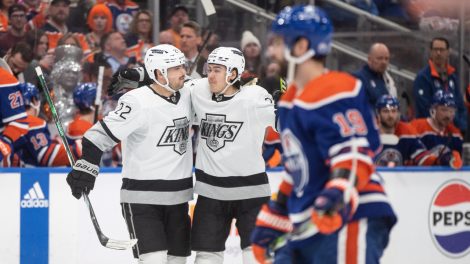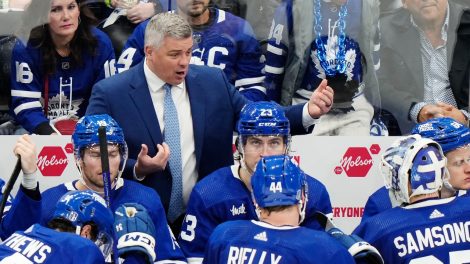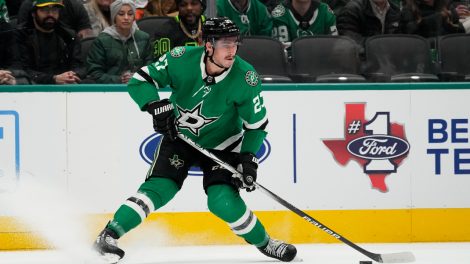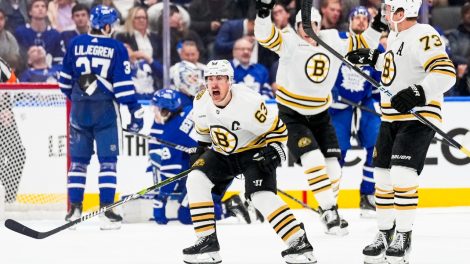This is going to be a monthly exercise.
We’re going to evaluate the top prospects of the Montreal Canadiens, and different players are going to be featured depending on what they show as the season progresses. There may very well be better prospects in the organization than the 10 that appear on this first edition of the list, but we’re starting with the players who have exhibited signs they have an NHL future.
We’re skipping forward Charles Hudon, who figures to be a fixture in Montreal for the majority of this season. He’s worked through three AHL seasons to get to this point, and we believe he’s moved past the stage of being a prospect. It’s time to see if he’s a full-time player.
To kick things off, we reached out to the best possible source to let us know what each player must do to climb their way up the ranks.
Martin Lapointe, who won two Stanley Cups over 15 seasons of playing in the NHL, served as the Canadiens director of player development for five seasons before taking over as director of player personnel in July. He’s a man who talks straight, and he gave us exceptional insight on the prospects of the organization and what they must focus on.
1. Charlie Lindgren, 23, G.
Undrafted. Signed out of St. Cloud State University in 2015.
SN: Any doubt this kid is ready for prime time?
Lapointe: To me, he can be back up anytime. For me, mentally, physically, he’s ready. He can be a backup anytime right now.
There’s nothing for him to work on to become a professional at this level. He’s proven he’s a mature kid. Coming from college — there is a difference coming from college than junior guys. You can have your exceptions in junior, but college guys usually are more mature and more pro-ready. He’s definitely that.
2. Victor Mete, 19, LD.
Drafted: Fourth round, 100th overall, 2016.
SN: What did you see in Mete that made for a recommendation out of development camp that he should get a good look with a partner like Shea Weber to start camp?
Lapointe: I want to be patient with the players and with young players in particular, but I think if you’re lacking in something and the young kid can bring that something you’re lacking … and if it doesn’t seem to faze him night in, night out … and if you can skate, retrieve pucks and move pucks, you can play. If you can do those three things and you’re able to defend, that’s what it comes down to. He’s smart enough to be able to defend against NHL players, in my opinion. Now there’s the factor of, “Are we going to burn him?”
But if you’re missing something or lacking something in your system, and you find a player who can fill the void, the age doesn’t matter. That’s my opinion.
He looks confident. He doesn’t second guess himself, he’s not caught in between. His passes are on the tape. When he gets the puck, he knows what he’s going to do with it. He knows he doesn’t have to do too much with it. He moves it to open space. That’s what you want to see. I wish defencemen played like that more often.
3.Noah Juulsen, 20, RD.
Drafted: First round, 26th overall, 2015
SN: We know Juulsen is solid in his own end, but does he have more offensive upside than he’s shown?
Lapointe: He’s going to be a Victor Mete with more size and strength. That’s all he has to do. As simple as that. He doesn’t need to go end-to-end with the puck. I don’t see him as an offensive defenceman; I see him as a puck-moving defenceman that can skate and will be tough to play against when he reaches his potential physically. I don’t think he’s reached that potential yet. He needs to fill out more.
4.Michael McNiven, 20, G.
Undrafted. Signed in 2015.
SN: Michael has been through some tough things at a young age, from losing his mother to not being drafted, and yet he’s coming off his best year of hockey. What does that say about him?
Lapointe: He’s had some tough things happen to him in his past, and he has a lot of character. He’s proven to us this year that he wants to be a player and that he’ll do whatever it takes to become a good pro. He lived in Montreal over the summer [with Canadiens prospect Simon Bourque’s family] and he trained with our guys, lost some pounds here and lived a healthier lifestyle.
We can give them all the resources, but at one point they have to take onus of it themselves. He’s doing that, and he did that last year.
5. Martin Reway, 22, LW.
Drafted: Fourth round, 116th overall, 2013.
SN: What’s the potential for Reway?
Lapointe: He’s got all the skills to be a top-six forward, and if he can put it all together shape-wise … He lost a full year [2016-17 with a rare heart condition] and the medication he was on made him gain 15 pounds. And when you don’t play for a full year, it’s tough to come back from that.
When I went to the Ivan Hlinka tournament [last August] we went to see him and told him — me and [Canadiens assistant general manager and director of amateur scouting] Trevor Timmins — “Take all the time you need. We know what you went through, it was very serious and it wasn’t easy.”
He liked the fact that we understood. We don’t want to put pressure on the kid, we want him to go to the [AHL’s] Laval [Rocket] and go get his game back. I don’t know how long it’s going to take. To miss a full year, it might take a full year for him to get it back. Practising is one thing, playing games and getting into game-shape is another. He has to come from a long ways, but he has all our support.
6.Brett Lernout, 22, RD.
Drafted: Third round, 73rd overall, 2014.
SN: What’s going to get this guy to the NHL?
Lapointe: When it’s tough to play against him, that’s what I like. When he gets involved physically and just keeps his game simple and moves the puck up, that’s all we ask of him. Play hard, be hard to play against, be physical and just make hockey plays. He’s not going to be an offensive player, and we all know that. But being able to make steady plays shift in, shift out is going to get him to the next level. Be consistent in that role and move pucks up the ice, and don’t be flashy.
He looks like a hockey player, he’s shaped like a hockey player, and now he has to be more mature in his game and bring that physicality on a consistent basis. He needs to really cherish that role and really believe that if he does that on a nightly basis, he’ll play 15 years in the NHL.
7. Michael McCarron, 22, C/RW.
Drafted: First round, 25th overall, 2013.
SN: When he was drafted, the general sense was that he’d be a five-year project. We’re in Year 5, and the most frequent criticism is that he doesn’t win enough battles for the puck for a player his size. Is that fair?
Lapointe: I’m not going to sit here and B.S. you; we all have eyes and we all know hockey to a degree, and it’s true that he needs to work on winning puck battles he shouldn’t lose. Because he’s 6-foot-6, his centre of gravity is a lot higher than most people. I think he needs to work on his core and his balance more than anything else, and obviously his first couple of skating strides — as everyone is aware.
I think he’s made strides, taken some good steps, but winning more puck battles when he goes in the corners and finishing more checks instead of missing checks is what we need to see. His timing is off still, I find. He wants to be on the puck, but sometimes he gets there and misses a check that turns into him being behind and having to backcheck. I want him to be more stick on puck, creating loose pucks, and I want him to grab those and come out of the corners with those loose pucks. Winning it and coming out of the corners and making plays; that’s what I’m missing from him.
He’s matured a lot and he wants to do the right thing. He stayed in Montreal and trained with a bunch of guys — Torrey Mitchell and Max Pacioretty –
and he’s got the right mindset. He’s gotta put everything together. He’s a big guy and it takes time.
8.Ryan Poehling, 18, C.
Drafted: First round, 25th overall, 2017.
SN: Fans seem to be really high on this player. What can you tell us about him?
Lapointe: I don’t know much about him because I haven’t seen him play college. I’ve only seen him in development camp. But from what I see right now, he’s going to be an NHL hockey player for sure. When? I don’t know. But to play at 16 years old in college [played at St. Cloud State in 2016-17], that’s pretty impressive on its own. To play with men, too, it’s tough. It’s not easy.
He just plays the right way. He plays a 200-foot game, he makes plays. He doesn’t have Martin Reway’s hands, but he makes really solid hockey plays. He’s a smart player and he can skate. He’s also going to fill out that 6-foot-2 frame. I think he’s going to play soon.
9.Will Bitten, 19, C/RW.
Drafted: Third round, 70th overall, 2016.
SN: We see a player with breakaway skill and nice finishing abilities. What do you see?
Lapointe: I like Will’s competitiveness, but sometimes he competes the wrong way. He tries to hit guys, be physical, and he wastes a lot of energy doing that. I see him jump to hit a guy, and he’s smaller and wasting a lot of energy with that. I want him to go into those battles, but instead of finishing a guy and trying to put him in the fourth row I’d rather see him try to dig pucks out. Knock the player off balance with a hip and win the space to come out of the corner. He’s quick. I think he has a tendency of — when things aren’t going well — he wants to come out like a pinball. That’s not going to be his game at the next level.
I just tell him to compete below the waist. I want him to be pest in the guy’s hands, the guy’s feet, the guy’s stick to come out with pucks. I want him to be like Brendan Gallagher. Gallagher doesn’t necessarily hit guys shoulder to shoulder, he hits guys in the hip, in the ass and in the hands and comes out with a lot of pucks. Or the puck stays there and the second wave of the forecheck comes in and grabs it. I don’t want Will to be overly physical for no reason. That’s an easy fix. He has the compete and wants to do the right thing, so I want him to work smarter.
[relatedlinks]
10.Simon Bourque, 20, LD.
Drafted: Sixth round, 177th overall, 2015.
SN: What’s going to get this player over the hump?
Lapointe: He has to make quicker decisions with the puck. I think in juniors he got put on the first power play and had more of an offensive role. When Thomas Chabot came to the Saint John Sea Dogs, he had more of an offensive role. But Bourque should be a quick puck-mover. I think he has a lot of thinking in his game right now. Too much can hurt his game. I think he’s caught a bit in between of wondering if he’s an offensive guy or a solid puck-mover. I think he needs to focus on just one and go with it, and I don’t think he should go offensive. He should just focus on being a steady puck-mover.
I think his skating needs to improve. He gets caught in those wide tracks and in that wide stance, so it’s not as efficient. But I think his skating can be really strong. It can be a lot better.
BONUS: Nikita Scherbak, 21, LW/RW.
Drafted: First round, 26th overall, 2014.
SN: I’m sure you noticed we left Scherbak out of our top 10. After watching him in training camp, we see a guy with an NHL body, who has worked hard and dedicated himself in the last two years to becoming more of a pro. But we’re often baffled by how frequently he appears to be on the wrong side of the puck. Is that a question of hockey sense or what?
Lapointe: For me it’s about maturity. You need to play a 200-foot game. Even all the skill that skill guys have — they can’t always play on one side of the puck and only be offensive. At one point in a hockey game, you’re going to have to play defence. It could be your second shift of the game. If you’re not able or willing to do that, you won’t be able to play because the coach won’t be willing to put you on the ice. Right now, he wants to play offensive, but he needs to play a 200-foot game. He might only have to play two shifts in the defensive zone, but he has to be able to chip a puck out and not lose the puck and get a turnover from it, because when that happens it looks like he doesn’t care about the play.
I think he’s cheating offensively, hoping that the puck will squirt loose. Details of the game are tough to do and demand more energy than what he tries to do by grabbing a puck at the end of his stick. If you don’t get your body involved physically, it’s less demanding. But he needs to understand he needs to get his body involved and that it’s going to hurt. You need to be huffing and puffing sometimes to win a puck, but hockey’s played like that. Winning puck battles — you may not score from it on this shift, but maybe you’ve done that part to help your teammate score. Maybe your teammate won’t score, but at least you’ll have been playing the right way. Scherbak needs to be willing to play the right way to make things happen and know his name might not end up on the scoresheet. That’s okay.









